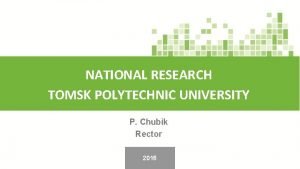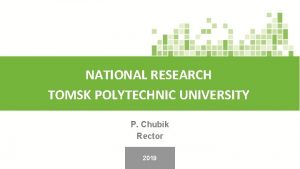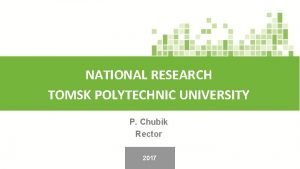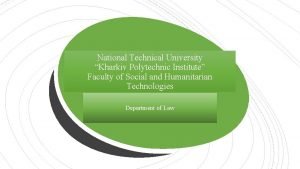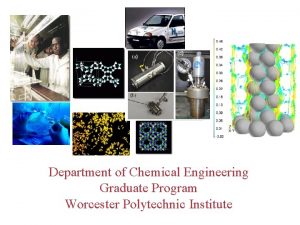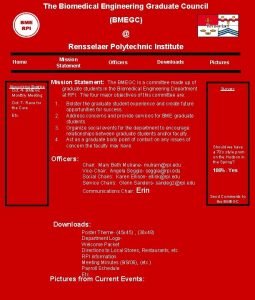NATIONAL RESEARCH TOMSK POLYTECHNIC UNIVERSITY Institute of High












- Slides: 12

NATIONAL RESEARCH TOMSK POLYTECHNIC UNIVERSITY Institute of High Technology Physics Silicate & Nanomaterial's Technology Department Science Technology and Society ВЫПОЛНИЛИ: Kalipa Kuakha ГРУППА: 4 ГМ 42 ПРОВЕРИЛА: К. С. Н. , КАРПОВА А. Ю. Томск – 2014

Science and technology have had both a positive and negative impact on society, especially in the following areas: Community Life Health Work Communication

The shift from nomadic life to farming led to the development of the city. • Networks of transportation, communication, and trade systems • Specialized labor • Government and religion • Social class Jerusalem, one of the world’s first cities, is still in existence today.

The nineteenth century witnessed the Industrial Revolution. Some of the negative aspects of the Industrial Revolution included poor working conditions and long hours. • Invention of textile manufacturing machines • Division of labor • Increase in production • Crowded cities • Unsafe and unhealthy working conditions

Technical innovations saved physical energy and lessened people’s workload. The tractor The vacuum cleaner The washing machine The refrigerator

The concept of leisure developed from labor-saving technology. People use the money they earn to take advantage of leisure time. Sporting Events Television Social Activities Movies

The greatest innovation of technology was longevity.

A large part of technology has been drastic to the advancement of medical science. Sir Alexander Fleming discovered penicillin, the first antibiotic, in 1928. In 1796, Edward Jenner paved the way for modern immunology by discovering a vaccine for smallpox. Dr. William Thomas Green Morton (c. 1846) was one of the first medical practitioners to use anesthesia on a patient before performing surgery.

Some current innovations could have a drastic impact on society. In 1997, scientists at the Roslin Institute in Edinburgh, Scotland, introduced Dolly the sheep, the first mammal ever to have been cloned. Dolly quickly became the symbol of the controversy over the ethics of cloning. Embryonic stem cell research is another area that is at the center of controversy. While stem cells might be able to be used to generate new organs for transplant, the use of them has many ethical considerations.

Inventions and innovations in communication have had a major influence on society. • Egypt: papyrus • Ancient Greece: public speaking, , drama, and philosophy • Ancient Rome: Roman alphabet • Modern Europe: printing press • World today: World Wide Web

Progress is a series of improvements in human life marked by inventions and discoveries. • Positive attributes of technology must be greater than negative attributes • Negative consequences: destruction of environment and loss of what it means to be human The Exxon Valdez oil spill off the coast of Alaska in 1989 impacted 1, 300 miles of shoreline and killed an enormous amount of wildlife.

Thanks
 Polytechnic
Polytechnic Tomsk polytechnic university rector
Tomsk polytechnic university rector Tomsk polytechnic university rector
Tomsk polytechnic university rector Tpu unipa
Tpu unipa Lviv polytechnic university
Lviv polytechnic university National technical university kharkiv polytechnic institute
National technical university kharkiv polytechnic institute Pnrpu
Pnrpu Shgm otomasyon
Shgm otomasyon Jhenaidah polytechnic institute
Jhenaidah polytechnic institute Dhaka polytechnic institute code
Dhaka polytechnic institute code Worcester polytechnic institute chemical engineering
Worcester polytechnic institute chemical engineering Rensselaer polytechnic institute electrical engineering
Rensselaer polytechnic institute electrical engineering Rensselaer polytechnic institute biomedical engineering
Rensselaer polytechnic institute biomedical engineering

